Cyerce antillensis from Florida
October 19, 2003
From: Skip Pierce

Hi Bill
I've attached 3 images of a slug that we'd guess is a species of either Cyerce or Polybranchia. It appeared out of some Penicillus that my post-doc Steve Massey collected near Tarpon Springs on the Gulf Coast of Florida. It is so transparent that it is difficult to photograph and I took these through a dissecting scope, so they're pretty flat. One image is a close up of a ceras. The body of the slug is green, so it's most likely been eating the Penicillus. Also, when I was photographing it, it was crawling furiously around in the dish until I put the stalk of Penicillus in, which the slug immediately crawled to and calmed down. It has 2 sets of rhinophores (I guess both sets are rhinophores)-the longer of which (proximal pair) is divided into 2 branches at the base. The cerata are either fairly delicate or easily autotomized. The collection was about 3 weeks ago (some time in early september) and the animal is approx 1cm long. I've never seen one before, but I think it would be very difficult to find it in the field unless you were looking for it. Just for fun, Steve will try to extract some DNA from autotomized cerata and we'll see what that tells us. Any ideas about the ID??
Skip
pierce@cas.usf.edu



Dear Skip,
This is almost certainly Cyerce antillensis Engel, 1927. My first thought was a species of Mourgona, two species of which have been described from the Caribbean, but since I can't see any sign of digestive gland in the cerata then this must be a species of Cyerce. The shape of the cerata fit descriptions and drawings of C. antillensis in various Marcus publications, including the dark spot on the cerata [which I have ringed in orange alongside]. I must say Colin Redfern's (2001) comment that it is found commonly with Penicillus dumetosus removed any doubt I had.
Best wishes
Bill Rudman
Related messages
-
Cyerce antillensis from St. Vincent
From: Linda Ianniello, August 30, 2007 -
Re: Cyerce antillensis from Florida
From: Kathe R. Jensen, October 20, 2003
